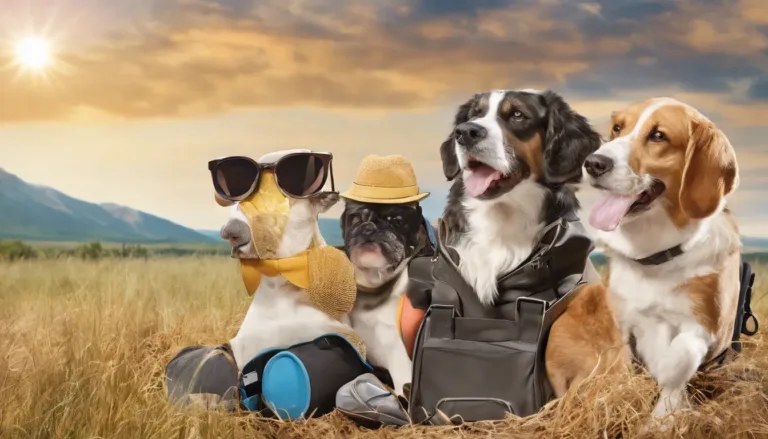Embarking on a journey with a furry companion introduces a unique set of considerations, particularly when flying with dogs. This form of travel requires preparation far beyond what is needed for human passengers alone, addressing both comfort and safety. The importance of understanding airline policies, securing the right gear, and ensuring your pet’s well-being cannot be overstated. For many, their dogs are not just pets but family members, making the need for a hassle-free trip even more critical. With the right preparation, flying with dogs can be a smooth and enjoyable experience for both the pet and the owner.
This article will guide readers through the essential steps to prepare for flying with dogs, ensuring nothing is overlooked. From choosing the right airline-approved pet carrier to understanding the importance of a pet car seat for safe airport transfers, each aspect will be covered. Additionally, we’ll discuss how to prepare your dog for the flight, highlighting the need for rest stops and the use of products like dog boots and sunscreen for protection in varying climates. We’ll delve into the critical paperwork and vaccination records needed, as well as tips for finding pet-friendly accommodations and ensuring a smooth airport experience. Equip yourself with the necessary knowledge to navigate the complexities of flying with your dog, including a pet first aid kit, absorbent mats for accidents, and collapsible bowls for hydration and feeding. By following these detailed pointers, travelers can ensure a comfortable and stress-free journey for their loyal companions.
Choosing the Right Travel Gear for Your Dog
Airline-Approved Pet Carriers
When traveling by plane, ensuring your dog’s safety and comfort starts with selecting the right airline-approved pet carrier. These carriers must fit under the seat in front of you and should provide ample room for your dog to stand, sit, and turn around comfortably. They should also be well-ventilated and constructed from durable materials to withstand the rigors of travel. Look for carriers that meet airline size specifications and offer features like comfortable bedding and secure closures [1][2].
Comfortable Harnesses and Leashes
A well-fitted harness is crucial for maintaining control and ensuring the safety of your dog during travel. Choose harnesses that distribute pressure evenly across the chest rather than the neck, which can prevent injury. Many travel-specific harnesses also feature reflective materials for increased visibility. Additionally, consider a leash that is both sturdy and gives your dog enough freedom to move without escaping [3][4][5].
Collapsible Bowls and Water Bottles
Hydration and feeding are critical, especially during long trips. Collapsible bowls are perfect for travel as they are lightweight, easy to pack, and can be used for both food and water. Pair these with a dog-specific water bottle, which is designed to prevent spills and allows easy drinking for your dog. Some bottles come with features like a built-in bowl and filtration systems to ensure your dog can drink clean water anywhere [1][2].
By equipping yourself with these essential travel items, you can ensure a smoother and more comfortable experience for both you and your dog.
Preparing Your Dog for the Flight
Getting Your Dog Used to the Carrier
To ensure a stress-free flight, it is essential to familiarize your dog with their carrier. Start by placing your dog in the carrier for short durations and gradually increase the time [6]. Make the carrier inviting by including treats and familiar toys [7][8]. For more effective results, place the carrier in common areas of your home where your dog can explore it comfortably [8]. Practice makes perfect, so consider simulating travel conditions by placing the carrier under a table or moving it around to mimic the motion of a vehicle [9].
Exercise and Feeding Before the Flight
Before heading to the airport, give your dog ample exercise and a chance to relieve themselves [6]. It’s advisable to feed your dog four hours before the flight to prevent any discomfort from a full stomach [6][10]. To manage hydration without mess, freeze a small tray of water that will melt by the time your dog needs it during the flight [10]. This preparation helps minimize the need for bathroom breaks and reduces the risk of motion sickness.
Calming Techniques and Tools
While it’s crucial to keep your dog calm during the flight, sedatives are not recommended due to potential health risks [6][9]. Instead, focus on natural calming techniques such as exposure to the sounds of an airport or using pet-specific essential oils [9]. Bringing along familiar items like a favorite toy or blanket can also help soothe your dog [8]. If possible, visit the airport beforehand to acclimate your dog to the busy environment [9].
Documents and Legal Requirements
Vaccination Records and Health Certificates
When traveling with a dog, it’s imperative to have all necessary health documentation. A health certificate, often required by both airlines and destination countries, verifies that a pet has received all necessary vaccinations and treatments [11][12]. These certificates are typically valid for a short period, usually 10 days for air travel and 30 days for land travel, necessitating timely planning and execution [11]. It is crucial to ensure that the health certificate is endorsed by a USDA-accredited veterinarian if traveling internationally, as this endorsement is a requirement for many countries [13].
Microchip Identification
Microchipping is a crucial step for identifying and ensuring the safety of pets during travel. An ISO 15-digit non-encrypted microchip, operating at 134.2 kHz, is the standard required by the European Union and many other countries [14][15]. This microchip helps in the easy identification and recovery of pets should they become lost. It is essential to register the microchip and keep the contact information up-to-date to facilitate a swift reunion with the pet if lost [14]. For pets with non-standard microchips, carrying a personal microchip scanner is recommended to avoid complications during travel [16].
Travel Permits and Airline Rules
Understanding and adhering to specific airline rules and obtaining the necessary travel permits are critical for a smooth travel experience with pets. Each airline has its own set of regulations regarding pet travel, which may allow pets in the cabin or cargo hold [17]. Additionally, the destination country may have specific entry requirements, such as import permits or additional health tests, which need to be arranged well in advance [18][12]. It is advisable to consult with a veterinarian early to ensure all conditions are met and to obtain all necessary documents and permits [17].
Tips for a Smooth Airport Experience
Navigating Airport Security with a Dog
Travelers should ensure their pets are in a hand-held travel carrier when approaching the security checkpoint. It is important to remove the pet from the carrier just before the screening starts and place the empty carrier on the conveyor belt for X-ray scanning [19][20][21][22]. Pets should never be placed in the X-ray tunnel, as this equipment is designed solely for screening personal property and carry-on luggage [19][20][21][22]. During the screening, owners can either carry their pets or have them walk through the metal detector on a leash, following the guidance of a TSA officer [19][20][21][22]. After the screening, it’s advisable to return the pet to its carrier at a re-composition area away from the main security checkpoint to ensure their safety and the safety of other passengers [19][20][21][22].
In-Cabin Tips
When flying with a pet in the cabin, familiarization with the carrier is crucial. Owners should acclimate their pets to the carrier by allowing them to spend time in it during the days leading up to the trip [19][20][21][6]. This reduces stress and helps pets feel more comfortable during the flight. It’s also important to be aware of “working” canines in the airport and to choose an alternate security checkpoint if necessary to avoid interference [19][20][21]. Knowing your pet’s temperament and maintaining control in a busy airport environment are key to preventing any issues during the screening process [19][20][21][6]. For pets that are skittish, requesting a private screening room may be a beneficial option [22].
Cargo Travel Tips for Larger Dogs
For those traveling with larger dogs in cargo, it is essential to ensure the pet is healthy and has been checked by a veterinarian, especially for breed-specific advice and necessary vaccinations [23][24]. Before the flight, do not feed your dog for at least four hours to minimize the risk of motion sickness and the need for bathroom breaks [23][24]. Exercise your dog before heading to the airport to help them relax during the flight [24]. When checking in, remove all restrictive items like leashes or collars from your dog to prevent any hazards in their crate [24]. Ensure that the crate is labeled clearly with your contact information and that your dog’s microchip details are up-to-date in case of any emergencies [24].
Conclusion
Throughout this article, we’ve navigated the complexities of flying with dogs, underscoring the importance of meticulous preparation to ensure a safe and comfortable journey for both pet and owner. From selecting the right airline-approved gear, familiarizing your dog with their travel carrier, to navigating the intricacies of airport security and in-flight strategies, we’ve covered essential steps to make air travel with your canine companion as smooth as possible. The emphasis on health documentation, understanding airline and destination requirements, and ensuring your dog’s well-being highlights the holistic approach needed for successful pet travel.
The journey with your furry friend need not be fraught with stress or complications. By adhering to the guidelines and tips discussed, pet owners can embark on air travel with confidence, knowing they are well-prepared. Remember, the key to a hassle-free experience lies in thorough preparation and a deep understanding of your dog’s needs. Sharing these adventures with your pet enriches your travels, bringing joy and memorable moments to cherish. As you plan for future trips, keep these insights in mind to ensure that you and your beloved pet enjoy many more journeys together, exploring the world from the skies.
FAQs
1. How does flying affect dogs?
Flying can be a stressful experience for dogs. However, this stress can be significantly reduced by providing familiar comforts and ensuring certain precautions are taken. Opting for a direct flight and choosing a suitable travel time can greatly alleviate your dog’s anxiety.
2. What steps should I take to prepare my dog for a long flight in the cargo hold?
To prepare your dog for a long flight in cargo, follow this step-by-step guide:
- Select a crate that complies with International Air Transport Association (IATA) standards.
- Get your dog used to the crate well before the flight.
- Schedule a visit to the veterinarian.
- Familiarize yourself with the airline’s policies and necessary documentation.
- Pack comfort items and essentials for your dog.
- Ensure your dog gets plenty of exercise before the flight.
- Arrive at the airport early.
3. How are dogs transported on long flights?
Dogs are transported in an IATA-compliant crate that is secured inside a specially designated area of the cargo hold. Most airlines prioritize boarding and disembarking for pets to minimize their stress. The crate is safely secured in place during the flight.
4. When should I stop giving my dog water before a flight?
You should continue to provide your dog with fresh water up until the time of the flight. It’s also advisable to have water available in the carrier during the flight if possible. Once you reach your destination, give your dog fresh water immediately.
References
[1] – https://www.amazon.com/collapsible-water-bottles-dogs/s?k=collapsible+water+bottles+for+dogs
[2] – https://www.rover.com/blog/best-dog-water-bottles-and-travel-dog-bowls/
[3] – https://www.nytimes.com/wirecutter/reviews/best-dog-harness/
[4] – https://www.amazon.com/dog-harnesses-travel/s?k=dog+harnesses+for+travel
[5] – https://www.dryfur.tv/metal-free-airport-travel-leash-harness-for-small-pets/
[6] – https://www.cesar.com/dog-care/pet-travel/12-tips-for-flying-with-your-dog
[7] – https://www.youtube.com/watch?v=iu-YebtXiIk
[8] – https://djangobrand.com/blogs/news/how-to-train-your-dog-to-love-riding-in-a-pet-travel-carrier
[9] – https://www.petmd.com/dog/slideshows/7-ways-comfort-your-dog-while-flying
[10] – https://be.chewy.com/pet-travel-feeding-tips-everything-you-need-to-know-about-feeding-your-pet-on-the-go/
[11] – https://www.petwellclinic.com/wp/2023/08/15/how-to-get-veterinary-health-certificate-pet-travel/
[12] – https://www.fdacs.gov/Consumer-Resources/Animals/Animal-Movement/Dog-and-Cat-Movement-Requirements/Travel-of-Dogs-Cats-and-Pet-Birds-in-out-of-Florida-FAQ
[13] – https://www.aphis.usda.gov/pet-travel/us-to-another-country-export/frequently-asked-questions-about-traveling-your-pet
[14] – https://www.pettravel.com/0001225.cfm
[15] – https://www.pettravel.com/passports_microchip_countries.cfm
[16] – https://www.akcreunite.org/travel/
[17] – https://www.cdc.gov/importation/traveling-with-pets.html
[18] – https://www.akc.org/expert-advice/travel/dog-pet-airline-travel-guidelines/
[19] – https://www.tsa.gov/news/press/releases/2023/02/24/tsa-tips-traveling-pets-through-security-checkpoint-washington
[20] – https://www.tsa.gov/news/press/releases/2022/12/14/tsa-offers-tips-traveling-small-pets-through-security-checkpoint
[21] – https://www.servicedogcertifications.org/airport-security-with-dog/
[22] – https://www.washingtonpost.com/travel/tips/flying-with-dogs-cats-advice/
[23] – https://pet-express.com/blog/how-to-fly-with-a-large-dog/
[24] – https://www.petvanlines.com/blog/how-to-fly-with-a-large-dog
Dog Care

